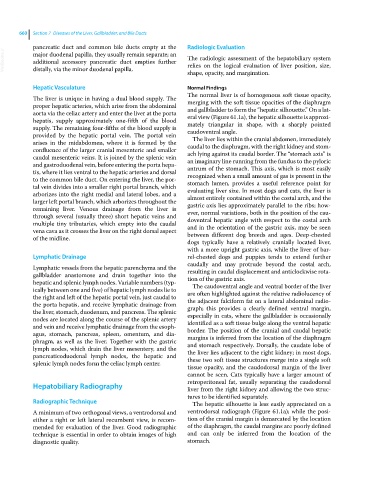Page 692 - Clinical Small Animal Internal Medicine
P. 692
660 Section 7 Diseases of the Liver, Gallbladder, and Bile Ducts
pancreatic duct and common bile ducts empty at the Radiologic Evaluation
VetBooks.ir major duodenal papilla, they usually remain separate; an The radiologic assessment of the hepatobiliary system
additional accessory pancreatic duct empties further
relies on the logical evaluation of liver position, size,
distally, via the minor duodenal papilla.
shape, opacity, and margination.
Hepatic Vasculature Normal Findings
The normal liver is of homogenous soft tissue opacity,
The liver is unique in having a dual blood supply. The merging with the soft tissue opacities of the diaphragm
proper hepatic arteries, which arise from the abdominal and gallbladder to form the “hepatic silhouette.” On a lat-
aorta via the celiac artery and enter the liver at the porta eral view (Figure 61.1a), the hepatic silhouette is approxi-
hepatis, supply approximately one‐fifth of the blood mately triangular in shape, with a sharply pointed
supply. The remaining four‐fifths of the blood supply is caudoventral angle.
provided by the hepatic portal vein. The portal vein The liver lies within the cranial abdomen, immediately
arises in the midabdomen, where it is formed by the caudal to the diaphragm, with the right kidney and stom-
confluence of the larger cranial mesenteric and smaller ach lying against its caudal border. The “stomach axis” is
caudal mesenteric veins. It is joined by the splenic vein an imaginary line running from the fundus to the pyloric
and gastroduodenal vein, before entering the porta hepa- antrum of the stomach. This axis, which is most easily
tis, where it lies ventral to the hepatic arteries and dorsal recognized when a small amount of gas is present in the
to the common bile duct. On entering the liver, the por- stomach lumen, provides a useful reference point for
tal vein divides into a smaller right portal branch, which evaluating liver size. In most dogs and cats, the liver is
arborizes into the right medial and lateral lobes, and a almost entirely contained within the costal arch, and the
larger left portal branch, which arborizes throughout the gastric axis lies approximately parallel to the ribs; how-
remaining liver. Venous drainage from the liver is ever, normal variations, both in the position of the cau-
through several (usually three) short hepatic veins and doventral hepatic angle with respect to the costal arch
multiple tiny tributaries, which empty into the caudal and in the orientation of the gastric axis, may be seen
vena cava as it crosses the liver on the right dorsal aspect between different dog breeds and ages. Deep‐chested
of the midline.
dogs typically have a relatively cranially located liver,
with a more upright gastric axis, while the liver of bar-
Lymphatic Drainage rel‐chested dogs and puppies tends to extend further
caudally and may protrude beyond the costal arch,
Lymphatic vessels from the hepatic parenchyma and the resulting in caudal displacement and anticlockwise rota-
gallbladder anastomose and drain together into the tion of the gastric axis.
hepatic and splenic lymph nodes. Variable numbers (typ- The caudoventral angle and ventral border of the liver
ically between one and five) of hepatic lymph nodes lie to are often highlighted against the relative radiolucency of
the right and left of the hepatic portal vein, just caudal to the adjacent falciform fat on a lateral abdominal radio-
the porta hepatis, and receive lymphatic drainage from graph; this provides a clearly defined ventral margin,
the liver, stomach, duodenum, and pancreas. The splenic especially in cats, where the gallbladder is occasionally
nodes are located along the course of the splenic artery identified as a soft tissue bulge along the ventral hepatic
and vein and receive lymphatic drainage from the esoph- border. The position of the cranial and caudal hepatic
agus, stomach, pancreas, spleen, omentum, and dia- margins is inferred from the location of the diaphragm
phragm, as well as the liver. Together with the gastric and stomach respectively. Dorsally, the caudate lobe of
lymph nodes, which drain the liver mesentery, and the the liver lies adjacent to the right kidney; in most dogs,
pancreaticoduodenal lymph nodes, the hepatic and these two soft tissue structures merge into a single soft
splenic lymph nodes form the celiac lymph center.
tissue opacity, and the caudodorsal margin of the liver
cannot be seen. Cats typically have a larger amount of
retroperitoneal fat, usually separating the caudodorsal
Hepatobiliary Radiography liver from the right kidney and allowing the two struc-
tures to be identified separately.
Radiographic Technique The hepatic silhouette is less easily appreciated on a
A minimum of two orthogonal views, a ventrodorsal and ventrodorsal radiograph (Figure 61.1a); while the posi-
either a right or left lateral recumbent view, is recom- tion of the cranial margin is demarcated by the location
mended for evaluation of the liver. Good radiographic of the diaphragm, the caudal margins are poorly defined
technique is essential in order to obtain images of high and can only be inferred from the location of the
diagnostic quality. stomach.

